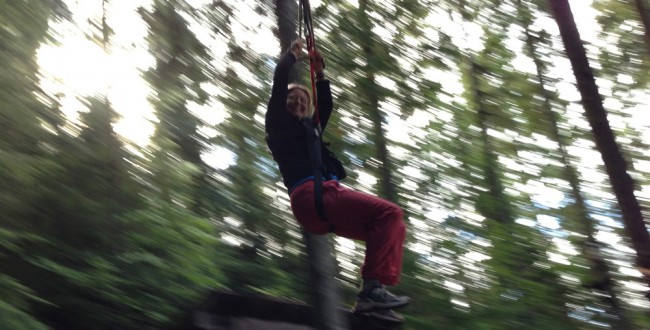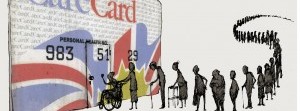
Photo Credit: Submitted
Coming out of the cave—Finding my diabetic tribe in the North
The chairlift seat sways gently as it whisks me up the hill. I lower the safety bar and catch my breath. Those steep runs through powder burn tons of calories! It’s time to check my blood-sugar level.
As a Type 1 diabetic, my body produces no insulin. Some people call it a disease. I think of it more as a disability—my pancreas doesn’t work. I must constantly measure my bloodstream’s glucose levels and either take insulin (if the level is too high) or eat something (if it’s low). I prick my finger and squeeze out a drop of blood, then touch it to the sensor on my blood-glucose monitor—a small iPod-sized gadget—and get a digital readout. I do this about 10 times—and inject insulin five times—each day.
“Whaaat?!!” I exclaim. The monitor indicates my blood-sugar level is 2.1—dangerously low. In most people, their correctly functioning pancreas automatically maintains a blood-sugar level of about 6.0. If mine drops much below 2.0, caused by an insulin rush, I could be in danger of passing out, potentially falling into a diabetic coma, followed by death if I don’t get an emergency glucagon injection. In my 33 years as a Type 1 diabetic, this has, thankfully, never happened to me–the passing out, or the death.
In a panic I reach into my pocket for dextrose tablets—sugar that digests straight into my bloodstream. I have stashes in all my pockets. Always. “This doesn’t make sense!” I tell my chairlift mates, hurriedly explaining I might be dropping into insulin shock, as I shovel handfuls of dextrose and raisins into my mouth.
At the top of the chair, in the warmth of the lodge, I check again. Yikes! My blood sugar has skyrocketed to 22! Or has it…? What the heck? Now I must inject insulin to bring the levels back down.
All these dramatic highs and lows are hard on the body. And the mind. In the short term, a high blood-sugar level feels like a bad hangover and can take a day to recover. In the long term, it can lead to scary complications like blindness, kidney failure, losing a foot…
Is there a problem with my monitor? It turns out, yes. It looks like it works, but reads inaccurately in the cold. I thought I was outsmarting it by keeping it warm inside my coat. Apparently not. This is a problem for an outdoor enthusiast in a snowy climate.
No longer a death sentence
I was 13 when, in the midst of a normal Vancouver childhood, I was diagnosed with Type 1 diabetes. Just 100 years ago, this would’ve been a death sentence. But the discovery of insulin in the 1920s allows Type 1 diabetics to live normal—or nearly normal—lives in most of the developed world, although life expectancy is 15 years shorter than the general population.
There are 300,000 Type 1 diabetics in Canada and some 750 to 1,500 of them live in northwest BC, according to stats. We are the “insulin-dependent” diabetics—only 10 percent of the greater diabetic population. Most diabetics are Type 2 and usually don’t require insulin injections.
More isolated in the North
In Vancouver there were a lot of supports to help me cope with my new life. I had appointments every three to six months with leading endocrinologists at BC Children’s and St Paul’s hospitals. As a young adult, I was encouraged to check in to diabetic clinics every couple years for educational diabetic “tune-ups.”
In the North, where populations are smaller and spread apart, resources are stretched a little thinner with 90 to 95 percent of diabetes-dedicated healthcare generally focussed on the demand, which is Type 2. Any Type 1 focus is largely dedicated to Type 1 kids and the newly-diagnosed who need it most. We don’t have any endocrinolgists here, so an appointment generally requires a Vancouver trip, and there’s not much demand for Type 1 “tune-up” clinics for adults. If afternoon clinics have ever been held, the Type 1s generally don’t show up, I’m told.
When I moved to Smithers in the mid-1990s, I simply maintained my same-old 1990s insulin regime. Diabetes technology and research were moving forward. But I wasn’t. Without realizing it, I let my diabetes care slide.
“Type 1s are pretty isolated up here,” says Shelley Irvine, diabetes nurse educator at Northern Health’s Healthy Living Centre in Smithers. “They don’t have the same access to educational resources—the conferences, clinics and meetings that happen a lot in metropolitan centres.”
She says Type 1 diabetics in the North have fewer appointments with an endocrinologist—if any at all—because of the travel and expense entailed. I haven’t seen an endocrinologist since I moved north.
Shelley is one of about 12 diabetes nurse educators spread out across the Northwest from McBride to Haida Gwaii. Four of those are in Prince George. All are part-time. In Smithers, we are lucky to have a nurse educator—and such a passionate one like Shelley. In places like Stewart and Dease Lake, there is little to no dedicated support.
Finding my tribe
That alarming chairlift ride was the kick in the pants I needed to get active again with my diabetes care. An intensive week of Googling led me to Sean Busby, a 29-year-old professional backcountry snowboarder. He’s a Type 1 diabetic from Montana.
“How do you do it?” I emailed him. “How do you check your blood-sugar levels in the cold?”
That email led me on a life-changing journey of introductions, inspiration and information. I felt like I was coming out of a cave. I discovered a huge community online—a movement of Type 1 diabetic-run organizations—where people were sharing stories, encouraging and learning from each other.
I started reading online forums and blogs, and finally ventured out to connect. I found myself zip-lining with other Type 1s at a weekend camp on Vancouver Island. I went to a national conference of Type 1 athletes and researchers in the US. I was euphoric—I felt drunk from all the new information and started incorporating new strategies into my daily regime. I learned about diabetic smartphone apps, better ways to take insulin and the “bionic pancreas” (watch for it on the shelves in about five years).
I met heroes like Doug Masiuk, a humble 39-year-old Type 1 diabetic who ran across America this year—the first Type 1 to do it.
“How many months? How far did you run each day? ” I asked him.
“About six months. About 20 to 30 miles, a few days a week.”
“That’s a marathon a day!” I gasped.
“Diabetes isn’t a sprint. It’s a marathon,” someone piped in.
This was the first time in 33 years I’d been in a room full of people like me. Diabetic gadgets beeped throughout the day and their owners would frequently glance at cellphone-sized insulin pumps or blood-sugar monitoring devices clipped to their belts. People poked their fingers to check blood-sugar levels at any time. It all felt so normal. I was in awe. There was instant recognition amongst everyone, even though most had never met. The feeling of “family” was impressive.
Our health professionals are doing a great job, and we couldn’t survive without them. But Type 1 diabetes is a complex condition with so many variables that come into play. Meeting other Type 1s who truly get it is kind of uplifting. It’s validating.
“Living with diabetes is like having a second full-time job,” says Jen Hanson, Executive Director at Connected in Motion, a Canadian charitable organization run by—and for—active adults with Type 1 diabetes. “There are no vacations…and, of course, no pay.”
Shedding the cloak
There is often a shyness among Type 1s. Along with conditions like epilepsy or renal failure, diabetes is one of those invisible conditions we’d rather not flaunt. We don’t want people to worry, panic or treat us differently, so many of us keep it under wraps.
A Type 1 in the Northwest talks excitedly that for the first time he’s just chatted with another Type 1. “I learned so much!” he says. Another tells me his co-workers don’t know he’s diabetic, but he’s “coming out of the closet.” In Smithers, a group of Type 1s will gather—most for the first time—in November.
Finding community is empowering—for anyone with a chronic condition. It’s informative, insightful and, most importantly, it’s good for your health. With resources and populations being fewer and farther between up here, perhaps we northerners need to find it the most.
________________________________
[sidebar]
Finding your type I tribe
So... where do you find them? Under rocks? On mountain tops? If you are looking for your Type 1 community, here are some ideas of where to start:
Go Local! FInd or make a group
- In Smithers, Type 1s will meet for a wine and cheese get together this November and will likely do it again. Contact your nearest diabetes education centre or this author for ideas and info.
Go Online! Some T1-specific websites
- Connected in Motion – Canadian organization run by—and for—active adults with Type 1 diabetes www.connectedinmotion.ca
- Riding on Insulin – Sean Busby’s organization focused on weekend gatherings for Type 1 kids, usually snowboarding camps in Canada and the US www.ridingoninsulin.org
- Insulin Dependence – focused on physical activity and peer support. US-based host of this summer’s national US conference on Type 1 and Sport. Great info on exercise and technology —worth checking out! www.insulindependence.org/resources/virtual-conference/
- Welcome to Type 1 – Canadian T1 filmmakers inform and inspire through video and documentary www.welcometotype1.com
- GLU – Boston-based collaborative data collection and sharing network, designed to accelerate research by listening to the collective voice of those living with T1D; excellent discussions, articles, and research for Type 1 diabetics www.myglu.org
- TUDiabetes.org www.tudiabetes.org
- JDRF Canada (Juvenile Diabetes Research Foundation) – research, advocacy and events www.jdrf.ca
- Diatribe – research and product news for people with diabetes www.diatribe.us
- 1run - Doug Masiuk’s site, shows current effort to set up annual 1 mile fundraiser runs across the US (no reason Canada can’t join in!) www.1run.org
- Integrated Diabetes Services – one-on-one consulting for people who use insulin, run by celebrated author of the book Think like a Pancreas – www.integrateddiabetes.com
- Take Control of Your Diabetes www.tcoyd.org
- T1 Active Living www.t1dactiveliving.com
Social Media
- All of the above on Facebook, Twitter & YouTube
Events:
- Snowboard Camp for Kids – Connected in Motion & Riding on Insulin , March 8, 2014, Nakiska Resort, Alberta
Other Resources: Favourite T1 books:
- The Diabetic Athlete’s Handbook by Sheri Colberg
- Think Like a Pancreas by Gary Scheiner
- Using Insulin: Everything You Need for Success by John Walsh








